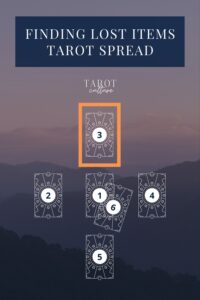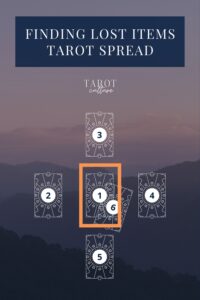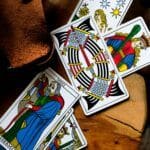Have you ever torn your home apart searching for your keys, wallet, or favorite book, only to end up more frustrated than before? It’s a universal experience, and while some might turn to traditional methods like retracing their steps or saying a quick St. Anthony prayer, others have found an unexpected ally: tarot cards. Yes, the same cards used to explore love, career, and life’s big questions can also help you locate missing items. Intrigued? Let’s dive in.
Think of tarot as your intuitive sidekick, piecing together the clues your subconscious already holds. By drawing cards and interpreting their symbols, you might uncover new insights about where to search. It’s not about magic or luck but about tapping into what you already know but haven’t consciously processed. Many people swear by tarot’s ability to nudge their memory or highlight places they’ve overlooked.
Table of Contents
Can You Use Tarot To Find Lost Items?
Absolutely! While tarot cards can’t magically locate your lost object, they work as tools to access your intuition and subconscious knowledge. When you misplace something, your brain often retains subtle clues about its whereabouts—even if you can’t immediately recall them. Tarot helps connect those dots, bridging what you know deep down and what you need to rediscover.
The key is understanding how to approach this process. Tarot readings for lost items are most effective when combined with a calm mindset and practical search methods. By using spreads tailored for locating objects, you can reframe your search and uncover insights you might have missed during the initial panic. Many people find that tarot reveals surprising details, guiding them to places they hadn’t thought to check.
How to Use Tarot to Find Lost Items
Before jumping into specific tarot spreads, preparing yourself and your space for the reading is essential. Choose a quiet, comfortable area where you can focus, and take a few deep breaths to center your mind. Shuffle your tarot deck while concentrating on the lost item—visualize it clearly in your mind, and set your intention to uncover its location. Once ready, you can explore the spreads below, designed to help locate missing items:

The Four-Card Directional Spread
The Four-Card Directional Spread is a simple yet effective way to pinpoint the general area where your lost item might be. To use this spread, place four cards in a cross formation, each one corresponding to a cardinal direction: north, south, east, and west. Focus on each card’s imagery and energy to determine which direction feels the strongest or most promising. For example, a card with vibrant, uplifting symbols might indicate the best direction to search, while darker, stagnant imagery could suggest a less likely area.
This spread is particularly useful when you suspect the item is in a confined space, such as your home, office, or car. By narrowing your focus to a specific direction, you can avoid wasting time searching in unproductive areas.
The Time Card Pull
The Time Card Pull offers a unique way to reconstruct the timeline of when you last interacted with the lost item. Start by drawing three cards: one for the past (when you last had the item), one for the present (its current location), and one for the future (where you’re likely to find it). Pay close attention to any time-related imagery in the cards. For example, a card depicting the sun might point to daytime hours, while the moon could suggest an evening event.
This method helps jog your memory about the item’s whereabouts and can guide your search by aligning the cards’ clues with specific times, places, or activities. It’s especially helpful when you’re unsure of when or where you lost the item.
The Location Spread
This detailed spread uses six cards to provide specific clues about your item’s location. Each card represents different aspects: height level (high/low), room type, furniture or container type, nearby objects, environmental conditions, and potential obstacles to finding it. The Location Spread gives you concrete details to guide your search, especially when you need help with where to begin looking.
The Journey Method
The Journey Method is perfect for retracing your steps and mapping out where your lost item might be. This spread involves drawing cards for each significant location or action you remember leading up to the moment you realized the item was missing. Think of it as creating a timeline, with each card representing a specific stop or event along the way.
For instance, if you were running errands, you might draw one card for each store or location you visited. The imagery and symbols in the cards can help jog your memory, guiding you to where the item might have been left behind. This method is particularly helpful when you’ve misplaced something outside your home or while traveling between locations.
The Yes/No Draw
Sometimes, you just need quick confirmation about whether to focus your search in a specific area. The Yes/No Draw offers a straightforward way to get that clarity. To use this method, hold your deck and ask a direct yes-or-no question, such as, “Is my item in the living room?” or “Did I leave it in the car?” Draw a single card to determine the answer.
In this approach, upright cards generally indicate “yes,” while reversed cards suggest “no.” While this method is not as detailed as other spreads, it can help eliminate unlikely locations and save time by narrowing your focus.
How to Read Tarot Spreads for Finding Lost Items
Reading tarot spreads for lost items requires focusing on the physical and situational details in the cards rather than their traditional meanings. Pay attention to visual cues and how they might connect to your surroundings. Each card in a spread represents a piece of the puzzle, offering insights into where and how to search.
Here’s a breakdown of typical card positions and what they might reveal:

Card Position #1
The first position typically reveals information about the item’s general location or the circumstances of its loss. Look for elements in the card that indicate indoor versus outdoor settings or cards that suggest specific places.
For example, the Four of Pentacles might suggest a storage space or somewhere you keep valuables, while the High Priestess could point to a hidden or overlooked spot.

Card Position #2
This position often provides clues about the physical characteristics of the surrounding area. Pay attention to the imagery’s details – are there references to furniture, natural elements, or specific materials?
The Eight of Wands might indicate a high shelf or elevated location, while the Page of Pentacles could suggest a study area or workspace.

This card will give you a clue about the specific place where the lost item is.
Look at the picture in your card:
Card Position #3
The third position frequently relates to timing or environmental conditions that help narrow your search. Consider both literal and symbolic interpretations.
The Moon card might suggest checking places you’d typically visit at night or areas with poor lighting, while the Sun could indicate well-lit spaces or locations you use during daytime hours.

Card Position #4
This position often reveals obstacles or challenges in finding the item. Cards here can warn you about potential blind spots in your search or suggest ways to overcome search difficulties.
The Tower might indicate the need to look in places that have been disrupted or reorganized, while the Hanged Man suggests viewing the situation from a different perspective.

Card Position #5
The fifth position provides insights about the item’s current condition or state. This can help manage expectations and guide your search approach.
The Four of Swords might indicate the item is safely stored but inactive, while the Ten of Wands could suggest it’s buried under other objects.

Card Position #6
The final position often guides the best approach to finding the item. This card might suggest specific actions or mindsets that will aid your search.
The Page of Cups could encourage following your intuition, while the Knight of Pentacles might advise a systematic, thorough search pattern.

What Questions to Ask When Using Tarot for Lost Items
Asking the right questions is crucial when conducting a tarot reading to find lost objects. Specific, open-ended questions can provide more actionable guidance than yes-or-no queries. Here are some examples of effective questions to ask during your reading:
- “What direction should I begin searching in?”
- “What type of environment is the item located in?”
- “Is the item hidden under or behind something?”
- “What was I doing the last time I had the item?”
- “What objects or landmarks are near the lost item?”
- “Should I focus on common or rarely-used areas?”
- “Is the item in a safe place, or has it been moved?”
By tailoring your questions to your situation, you can gain clearer insights into where to search and what factors might help locate the item.
What to Do Once You Find the Item
After successfully finding your lost item with tarot, take a moment to reflect on the process. Document the spread and the cards that provided the most accurate guidance. Creating a journal or log of your readings can help you build a personalized system for interpreting the cards in future searches.
To prevent future losses, consider implementing practical strategies, like creating designated spots for frequently misplaced items or using technology like Bluetooth trackers for valuables. These small habits can save you time and stress in the long run.
Lastly, don’t forget to cleanse and thank your tarot deck. Whether through a simple shuffle, a moment of gratitude, or leaving the deck in a peaceful spot, this practice helps maintain your connection to the cards and sets the tone for future readings.
Alternatives for Finding Lost Items
While tarot is a unique and intuitive tool, there are other methods to locate missing items:
- Systematic Search: Work methodically, room by room, to ensure no area is overlooked.
- Mindfulness Techniques: Practice meditation or visualization to recall your last interactions with the item.
- Technology: Use Bluetooth trackers or smart home devices to find electronic items.
- Dowsing Pendulum: Explore divination tools like a pendulum for additional insights.
- Professional Help: Consult a psychic or medium if you feel stuck and need further guidance.
Conclusion
Tarot spreads for finding lost items offer a creative and insightful way to recover misplaced belongings. While they shouldn’t replace practical search methods, these spreads can provide valuable clues, new perspectives, and a sense of calm during your search. By combining tarot with mindfulness and practical strategies, you can tap into your intuition and locate missing objects with surprising ease.
Whether you’re an experienced tarot reader or a curious beginner, exploring these spreads can transform how you approach the challenge of lost items. So next time your keys or wallet go missing, grab your deck, take a deep breath, and let the cards guide you to success.











